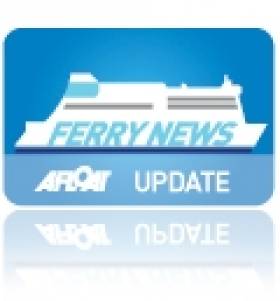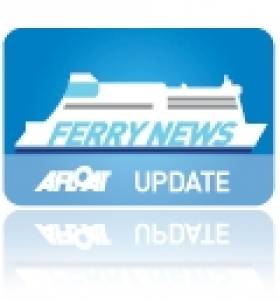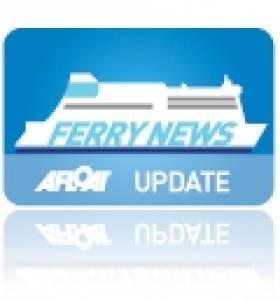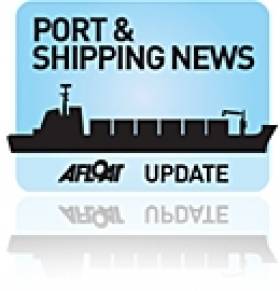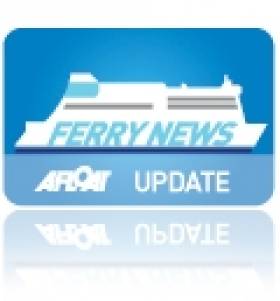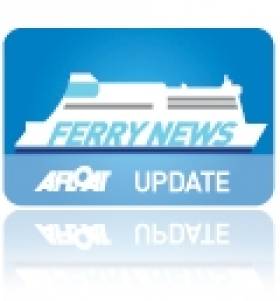Displaying items by tag: DFDS Seaways
#P&Oferries – Lysblink Seaways under repair in Greenock, Scotland as previously reported on Afloat, is where by coincidence DFDS Seaways operate a container service to Liverpool and from where they have chartered a freight-ferry to P&O Ferries, writes Jehan Ashmore.
Firstly is the charter by DFDS Logistics Rederi AS of Lysblink Seaways to Sea-Cargo based in Bergen.
The starboard side-loading paper products carrier was due to have called to Skogn, in Norway last month from Belfast but instead the 129m long vessel went aground on the west Scottish coast.
She was re-floated and towed to the Clyde where she entered Garvel Clyde's James Watt Dock at Inchgreen.
While on the Irish Sea, the freight-only Anglia Seaways charter from DFDS to serve P&O Ferries Dublin-Liverpool route had only begun earlier this week having called to Merseyside last weekend from The Netherlands.
Anglia Seaways is covering the roster of P&O's ro-pax Norbank which is in dry dock at Cammell Laird, Birkenhead. Also maintaining the Ireland-England central Irish Sea route is sister Norbay and larger ro-pax European Endeavour which also carries motorist cars and freight vehicles.
The Danish flagged 120-trailer Anglia Seaways is otherwise understood to normally operate on the North Sea, running Rotterdam-Immingham on the UK's east coast. It is from Anglia where she originally began a career with Norfolkline (a Maersk subsidiary) but running from Felixstowe firstly as the Maersk Anglia.
It's almost full circle with Anglia Seaways presence on the Irish Sea, as she has served on several routes, the most recent a charter to Seatruck Ferries on the Warrenpoint-Heysham route until last year.
More apt was the role she played for DFDS Seaways when the Danish shipping giant's acquisition of Norfolkline Irish Sea operations in 2010.
The involved a network of routes that would be later sold to Stena Line, except for the Dublin-Birkenhead service in which Anglia Seaways served until January 2011.
This marked the final trace of the short-lived DFDS freight and 'passenger' operations that Stena would eventually swallow up to further consolidate as the dominant player on the Irish Sea.
For a more in-depth coverage of this period in the Irish Sea ferry industry (including a photo of Anglia Seaways) while still sporting the distinctive pale blue corporate Maersk hull colour.
Also seen at Dublin Port was the ro-pax Liverpool Seaways, which would head off for a career with DFDS on the Baltic Sea.
Stena's Dublin Route ‘Nordica’ to Transfer to Newcomer's Former Dover Role
#ShipsSwap – Stena Nordica is due to leave the Dublin-Holyhead route next month in a swap that sees replacement 'Superfast X' which as previously reported had served on the Straits of Dover, writes Jehan Ashmore.
Stena Line are to transfer the outgoing 'Nordica' (see related report) to DFDS Seaways Dover-Calais route from where the newcomer Stena Superfast X had operated the UK-France link under the name Dieppe Seaways.
The 29,800 tonnes 'Superfast' ceased Straits of Dover sailings last November when a two-year charter from Stena Ro Ro had expired. She is to join the Dublin-Holyhead route's second ship Stena Adventurer in her new Irish Sea role.
The move is a consolidation and expansion of services by Stena Line out of Dublin Port following the announcement to close the neighbouring route from Dun Laoghaire to Wales.
DFDS Seaways has confirmed that it will be adding the Nordica to the short-sea link following the ro-pax's final sailing for Stena scheduled on 8 March prior. In turn the Stena Superfast X is set to make her inaugural sailing in the early hours of the next day.
The entry of Nordica will bring DFDS Seaways' France fleet back to five vessels since Dieppe Seaways stood down and went to layup in Dunkerque.
She is undergoing in Poland as reported on Afloat.ie a major refit and conversion by MacGregor at Romentowa's Nauta Yard in Gdynia.
Likewise the Nordica will be dry-docked for a refit and rebranding before joining the DFDS Seaways single route operated ferry, Calais Seaways. The 405 passenger newcomer is expected to be ready for business in the next couple of months.
Carsten Jensen, senior vice president at DFDS Seaways, commented: "We have been looking for a suitable fifth ship on our Dover-France routes to bring our Calais service back up to two vessels".
"The introduction of the Nordica, coupled with an engine upgrade on Calais Seaways, will help us restore a reliable daily service of up to 20 sailings between Dover and Calais, which is good news for our customers and good news for our loyal crew and operations teams too."
The newcomer is to serve the premier UK-continent link in which last month a case by the Competition Appeal Tribunal's ruling on the SCOP/Eurotunnel was welcomed by DFDS Seaways.
Another Blow to UK South Coast Ports As Route Faces Closure
#EnglishChannel - DFDS Seaways plan to close Portsmouth-Le Havre route later this year, the announcement follows partners LD Lines which closed services also from another UK south coast port to Spain just over a week ago, writes Jehan Ashmore.
According to the Danish owned DFDS, they cite the closure is due to continued losses and that they have held consultations with French unions. The route carried 185,000 passengers and 480,000 lane-metres of freight in 2013 generating revenues of DKK 165m.
The route forms a network of English Channel and Mediterranean services run in a partnership between DFDS Seaways and Louis Dreyfus Armatuers (LDA) through is ferry brand LD Lines now reduced to the St.Nazaire-Gijon route and a France-Tunisia link.
As previously reported, LD Lines 'Irish' leg of the Spanish landbridge route was closed last month, when the service was withdrawn between the French port and Rosslare.
Returning to the Portsmouth-Le Havre route, this is served by a time-chartered ro-pax ship, understood to be Seven Sisters (2005/18,940grt). The French-flagged vessel and crew will be redelivered to her owners at the end of 2014.
According to DFDS, a number of initiatives to improve the route's financial performance since the route was taken over from (LDA) in 2012 have had limited effect, yet leaving LD Lines to continue running their remaining services in the partnership.
DFDS also claim given unsatisfactory financial results, the measures already taken and new EU sulphur emission rules coming into force on 1 January 2015, the route does not have a viable future.
Another DFDS route, Harwich-Esbjerg which is not part of the partnership with LD Lines is to close later this month. The withdrawal of what is the only ferry service connecting UK and Scandinavian is once again due in part to the introduction of sulphur directives.
Birkenhead Docks Upbeat On Future Growth
#PORTS – The operator of Birkenhead Docks at Twelve Quays Terminal, says it is confident it will recover the business it lost when DFDS Seaways closed down ferry operations last year, according to a report in today's Liverpool Daily Post.
Birkenhead Port, part of the Peel Group, says overall tonnage for the year to March stood at 3.2m tonnes – down 3% on the previous year. It said the fall was due to DFDS's decision to shut its Birkenhead-Dublin routes in January, 2011 (click HERE).
In accounts newly filed at Companies House, Birkenhead Port said business for the first ten months of the year had been strong. But it said that, in the final quarter, ongoing growth on its Belfast route was "more than offset by the loss of all Dublin volume".
It added: "While, in the short term, the loss of the DFDS business will adversely impact revenues and overall financial result, in the medium term the directors are confident that the company will recover this lost business as we look to contract with another operator at this flagship, purpose-built roll-on, roll-off facility."
It said that, with Stena Line axing its Fleetwood-Larne service, Birkenhead could attract more business to its Belfast route.
Seatruck’s New Freight-Ferry to Make December Debut
Seatruck, which claims 20% of the Irish Sea market compared to just 3.7% in 2004, says it will transport 300,000 units in 2011 on its four routes: Dublin-Liverpool, Dublin-Heysham, Warrenpoint-Heysham and Larne-Larne. With the introduction of the newer larger vessels, Seatruck is aiming at the 45% of Irish Sea freight market that is still driver-accompanied.
Alistair Eagles, MD of Seatruck (Irish Sea) says that his company's share of unaccompanied freight volumes is set to grow in 2012, although the total Irish Sea ro-ro market is set to remain static next year, but better than a 1% decline in 2011.
Mr Eagles said: "We believe that our sector of the market — freight-only unaccompanied — will continue to grow. By offering pure freight services we can keep the costs down relatively lower compared with the combined passenger and freight ferry operators.
"We are seeing a switch away from driver-accompanied shipments because hauliers can save quite a lot of money."
Seatruck also benefited from a radical shake-up on the Irish Sea ferry market, with largescale withdrawals of capacity by DFDS and other changes, notably taking over the Dublin-Heysham route in February, to read more click HERE. The route is served by the chartered 120-unit Anglia Seaways which has accommodation for 12 drivers.
As for the remaining newbuild pair, they are scheduled for delivery from FGS during the first half of 2012 and deployed on yet-to-be announced routes. Like the new quartet, the same number were ordered of the 'P' class which entered service from 2008 onwards which included Clipper Pace and Clipper Panorama which currently operate 22 weekly sailings on the Warrenpoint-Heysham route.
Seatruck also operate Clipper Ranger and Arrow on Larne-Heysham sailings, where they each provide a capacity of 65 units and offer driver accompanied traffic with accommodation in en-suite cabins.
The older sisters will both be replaced when the second newbuild Seatruck Power (for previous report click HERE) comes on stream in mid-February 2012.
{youtube.com}=90b-c1j0S_E{/youtube.com}
Launching of M.V. Seatruck Power at FGS, Germany
Seatruck, which claims 20% of the Irish Sea market compared to just 3.7% in 2004, says it will transport 300,000 units in 2011 on its four routes: Dublin-Liverpool, Dublin-Heysham, Warrenpoint-Heysham and Larne-Larne. With the introduction of the newer larger vessels, Seatruck is aiming at the 45% of Irish Sea freight market that is still driver-accompanied.
Alistair Eagles, MD of Seatruck (Irish Sea) says that his company's share of unaccompanied freight volumes is set to grow in 2012, although the total Irish Sea ro-ro market is set to remain static next year, but better than a 1% decline in 2011.
Mr Eagles said: "We believe that our sector of the market — freight-only unaccompanied — will continue to grow. By offering pure freight services we can keep the costs down relatively lower compared with the combined passenger and freight ferry operators.
"We are seeing a switch away from driver-accompanied shipments because hauliers can save quite a lot of money."
Seatruck also benefited from a radical shake-up on the Irish Sea ferry market, with largescale withdrawals of capacity by DFDS and other changes, notably taking over the Dublin-Heysham route in February, to read more click HERE. The route is served by the chartered 120-unit Anglia Seaways which has accommodation for 12 drivers.
As for the remaining newbuild pair, they are scheduled for delivery from FGS during the first half of 2012 and deployed on yet-to-be announced routes. Like the new quartet, the same number were ordered of the 'P' class which entered service from 2008 onwards which included Clipper Pace and Clipper Panorama which currently operate 22 weekly on Warrenpoint-Heysham sailings.
Seatruck also operate Clipper Ranger and Arrow on Larne-Heysham sailings where they each provide a capacity of 65 units and offer a limited number of driver accompanied traffic accommodation in en-suite cabins.
Stena Superfast VII Departs Poland for New Belfast-Cairnryan Route

The New Superfast leaves Gdansk
The 30,285grt newcomer and her sister Stena Superfast VIII will become the largest ever ferries running on the North Channel , though prior to entering service on 21 November, they will undertake berthing trials and crew training.
For the next two-years the sisters are on charter from Scandinavian operators Tallink, and are to operate the new 2 hour 15 minute route with 12 crossings daily. The ten-deck ships can carry up to 1200 passengers, 660 cars or 110 freight units. The sisters will be re-gistered in their new homport of Belfast.
The relocation of Scottish ferry port and the introduction of the Superfast sisters will replace the existing pair of conventional ferry tonnage, Stena Caledonia and Stena Navigator (1984/15,229gt) the latter vessel is believed to be sold. In addition HSS sailings will cease causing the HSS Stena Voyager to become redundant, she was the second of the trio of pioneering HSS 1500 craft built.
When Stena Superfast VII departed Gdansk, she passed the Stena Vision which operates Stena Line's Karlskrona-Gdynia route, the Baltic Sea city lies to the west of Gdansk. Also in Gdansk was the Stena Feronia, the former Irish Sea serving Visentini built ro-pax Dublin Seaways, which was operated albeit briefly by DFDS Seaways last year on the Dublin-(Birkenhead) Liverpool service.
She served under her new Scandinavian owners but the firm's first foray into the Irish market lasted a mere six months. DFDS Seaways sold their Irish Sea network to Stena Line (to read report click HERE) with the exception of their Dublin-Birkenhead service which closed. In addition the Dublin-Heysham freight-only route which closed until re-opened by Seatruck Ferries. The route is currently served by Anglia Seaways, the freightferry which DFDS previously used on the route is on charter to the operator.
- DFDS Seaways
- Baltic Sea
- Stena Line
- Ports and Shipping News
- Seatruck Ferries
- North Channel
- Stranraer
- Dublin Seaways
- Ferry news
- Tallink
- Loch Ryan Port
- HSS Stena Voyager
- Stena Caledonia
- Stena Navigator
- Belfast Lough News
- HSS
- Visentini ropax
- BelfastCairnryan
- Stena Superfast VII
- Stena Superfast VIII
- Stena Superfast
- Superfast Sisters
- North Channel ferry routes
- Stena Feronia
- LRP
- BirkenheadBelfast
- DublinBirkenhead
Sponsorships of Ice-Sea Giants
Stena Line themselves will be looking forward to introducing their own giants when two of the largest ferries are to be introduced on the North Channel in the Autumn. The two chartered 30,000grt sisterships are Superfast VII and Superfast VIII. To see the vessel breaking through an an ice-flow, click PHOTO. The 203m long pair can take 1,200 passengers, around 660 cars or 110 freight vehicles. To read more about these 'Superfast' class vessels and the new £80 port terminal click HERE.
The company's area director Michael McGrath said: "It's quite fitting that we are teaming up with the Stena Line Belfast Giants at this time as we prepare to introduce two of the largest ferries every to sail between Northern Ireland and Scotland when we open our new route and port in Cairnryan this November. The two Superfast vessels will be another two Giants to add to our team."
Last year Stena Line made a £40m acquisition of the Belfast to Liverpool (Birkenhead) and Heysham routes and four vessels from DFDS Seaways. The deal was approved by the Irish authorities but remained subject to clearance from the UK's Competition Commission until late last month when they fully approved the acquisition.
This brings to six routes the company runs on its Irish Sea route network where over two million passengers were carried each year, more than its rival ferry operators combined.
- DFDS Seaways
- Belfast Harbour
- Stena Line
- North Channel
- Competition Commission
- BelfastHeysham
- Superfast VII
- Superfast VIII
- Belfast Lough News
- Belfast Port
- Odyssey Arena
- Belfast Giants
- BelfastCairnryan
- New ferryport
- Nottingham Panthers
- Sheffield Steelers
- Hockey Festival Weekend
- BelfastLiverpool (Birkenhead)
- Irish Sea ferry companies
- Irish icehockey
Irish Authorities Approve Stena / DFDS Merger
Of the two services, the Belfast-Liverpool (Birkenhead) is for passengers and freight while the and Belfast-Heysham port route is exclusively for freight-only users. To read more about the decision from the authority click here.
In February the UK's Office of Fair Trading (OFT) referred Stena AB's acquisition from DFDS A/S to the Competition Commission, conclusions on the report are not expected to be made until 25 July. To read more about the merger click here.
In the meantime the Belfast-Liverpool (Birkenhead) route continues trading under the name of Stena Line Irish Sea Ferries Ltd which is separately operated to Stena Line's other Irish Sea routes.
Sailings on the 8-hour route are run by the Italian built 27,510 tonnes ro-pax twins Lagan Seaways and Mersey Seaways which have been in service since the newbuilds were launched in 2005.
As the acquisition remains subject to regulatory clearance, passengers intending to travel on the route can continue to make bookings through the DFDS Seaways website by logging onto this link.
In addition the acquisition involved the sale of the South Korean built freight-ferries Hibernia Seaways and Scotia Seaways which operate Belfast-Heysham sailings.
Stena to Re-Introduce HSS this Week
Stena Line's HSS fast-ferry the Stena Explorer will be re-introduced on its Dun Laoghaire to Holyhead route this Friday, writes Jehan Ashmore.
The HSS (High Speed Service) operated 19,638 tonnes craft will run between 1 April to 13 September to cope with the additional demand over the summer period.
A single daily round trip is scheduled with a 10.00 hours sailing from Holyhead and a 13.15 hours sailing from Dun Laoghaire. Passage time is 120 minutes (2 hours).
The HSS can 350 vehicles and with 1500 passengers, the craft can handle higher volumes of seasonal summer foot passengers compared to the last route serving vessel, the 4,113 tonnes Stena Lynx III. The return of the HSS service links in with those intending to make onward journeys from Dun Laoghaire's DART commuter rail service to Dublin city centre and beyond on the national rail network.
Up to early January the route had been served by the Stena Lynx III which remains moored alongside Dun Laoghaire's St. Michaels Wharf. The craft which can take 627 passengers and 120 cars and marketed as the Stena 'Express' is to resume high season sailings starting in July between Rosslare-Fishguard.
In total the company carries over two million passengers on its four Irish Sea routes each year. An additional route between Belfast-Liverpool (Birkenhead) was taken over by the Swedish owned ferry company from DFDS Seaways late last year, is subject to regulatory clearance.
Until such clearance has been granted, this route will be operated separately from all other Stena Line routes. In the meantime the company advise until further notice to make bookings which will remain acceptable through the use of the DFDS website.





























